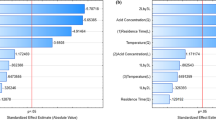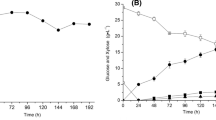Abstract
Rice straw hemicellulosic hydrolysate was used as fermentation medium for ethanol production by Pichia stipitis NRRL Y-7124. Shaking bath experiments were initially performed aiming to establish the best initial xylose concentration to be used in this bioconversion process. In the sequence, assays were carried out under different agitation (100 to 200 rpm) and aeration (V flask/V medium ratio varying from 2.5 to 5.0) conditions, and the influence of these variables on the fermentative parameters values (ethanol yield factor, Y P/S; cell yield factor, Y X/S; and ethanol volumetric productivity, Q P) was investigated through a 22 full-factorial design. Initial xylose concentration of about 50 g/l was the most suitable for the development of this process, since the yeast was able to convert substrate in product with high efficiency. The factorial design assays showed a strong influence of both process variables in all the evaluated responses. The agitation and aeration increase caused a deviation in the yeast metabolism from ethanol to biomass production. The best results (Y P/S = 0.37 g/g and Q P = 0.39 g/l.h) were found when the lowest aeration (2.5 V flask/V medium ratio) and highest agitation (200 rpm) levels were employed. Under this condition, a process efficiency of 72.5% was achieved. These results demonstrated that the establishment of adequate conditions of aeration is of great relevance to improve the ethanol production from xylose by Pichia stipitis, using rice straw hemicellulosic hydrolysate as fermentation medium.

Similar content being viewed by others
References
Hu, G., Heitmann, J. A., & Rojas, O. J. (2008). Bioresources, 3, 270–294.
Kumar, A., Singh, L. K., & Ghosh, S. (2009). Bioresource Technology, 100, 3293–3297. doi:10.1016/j.biortech.2009.02.023.
Demirbas, A. (2005). Energy Sources, 27, 327–337. doi:10.1080/00908310390266643.
Zaldivar, J., Nielsen, J., & Olsson, L. (2001). Applied Microbiology and Biotechnology, 56, 17–34. doi:10.1007/s002530100624.
Duff, S. J. B., & Murray, W. D. (1996). Bioresource Technology, 55, 1–33. doi:10.1016/0960-8524(95)00122-0.
Mussatto, S. I., & Roberto, I. C. (2004). Bioresource Technology, 93, 1–10. doi:10.1016/j.biortech.2003.10.005.
Hahn-Hägėrdal, B., Jeppsson, H., Skoog, K., & Prior, B. A. (1994). Enzyme and Microbial Technology, 16, 933–943. doi:10.1016/0141-0229(94)90002-7.
Millati, R., Edebo, L., & Taherzadeh, M. J. (2004). Enzyme and Microbial Technology, 36, 294–300. doi:10.1016/j.enzmictec.2004.09.007.
Sanchez, G., Pilcher, L., Roslander, C., Modig, T., Galbe, M., & Linden, G. (2004). Bioresource Technology, 93, 249–256. doi:10.1016/j.biortech.2003.11.003.
Agbogbo, F. K., & Coward-Kelly, G. (2008). Biotechnology Letters, 30, 1515–1524. doi:10.1007/s10529-008-9728-z.
Sánchez, S., Bravo, V., Castro, E., Moya, A. J., & Camacho, F. (2002). Journal of Chemical Technology and Biotechnology, 77, 641–648. doi:10.1002/jctb.622.
Sunitha, K., Lee, J. K., & Oh, T. K. (1999). Bioprocess and Biosystems Engineering, 21, 477–481. doi:10.1007/PL00009086.
du Preez, J. C. (1994). Enzyme and Microbial Technology, 16, 944–956. doi:10.1016/0141-0229(94)90003-5.
Taniguchi, M., Tohma, T., Itaya, T., & Fujii, M. (1997). Journal of Fermentation and Bioengineering, 83, 364–370. doi:10.1016/S0922-338X(97)80143-2.
Nigam, J. N. (2001). Journal of Industrial Microbiology and Biotechnology, 26, 145–150. doi:10.1038/sj.jim.7000098.
Mussatto, S. I., & Roberto, I. C. (2005). Brazilian Archives of Biology and Technology, 48, 497–502. doi:10.1590/S1516-89132005000300020.
Roberto, I. C., Mussatto, S. I., & Rodrigues, R. C. L. B. (2003). Industrial Crops and Products, 17, 171–176. doi:10.1016/S0926-6690(02)00095-X.
Mussatto, S. I., & Roberto, I. C. (2004). Biotechnology Progress, 20, 134–139. doi:10.1021/bp034207i.
Diaz, M. J., Ruiz, E., Romero, I., Cara, C., Moya, M., & Castro, E. (2009). World Journal of Microbiology and Biotechnology, 25, 891–899. doi:10.1007/s11274-009-9966-9.
Cantarella, M., Cantarella, L., Gallifuoco, A., Spera, A., & Alfani, F. (2004). Biotechnology Progress, 20, 200–206. doi:10.1021/bp0257978.
Liu, Z. L., Slininger, P. J., Dien, B. S., Berhow, M. A., Kurtzman, C. P., & Gorsick, S. W. (2004). Journal of Industrial Microbiology and Biotechnology, 31, 345–352. doi:10.1007/s10295-004-0148-3.
Liu, Z. L., Slininger, P. J., & Gorsick, S. W. (2005). Applied Biochemistry and Biotechnology, 121–124, 451–460. doi:10.1007/978-1-59259-991-2.
Agbogbo, F. K., & Wenger, K. S. (2007). Journal of Industrial Microbiology and Biotechnology, 34, 723–727. doi:10.1007/s10295-007-0247-z.
du Preez, J. C., Bosch, M., & Prior, B. A. (1986). Enzyme and Microbial Technology, 8, 360–364. doi:10.1016/0141-0229(86)90136-5.
Telli-Okur, M., & Eken-Saraçoglu, N. (2008). Bioresource Technology, 99, 2162–2169. doi:10.1016/j.biortech.2007.05.036.
Skoog, K., & Hahn-Hagerdahl, B. (1990). Applied and Environmental Microbiology, 56, 3389–3394.
Klinner, U., Fluthgraf, S., Freese, S., & Passoth, V. (2005). Applied Microbiology and Biotechnology, 67, 247–253. doi:10.1007/s00253-004-1746-8.
Slininger, P. J., Bothast, R. J., Okos, M. R., & Ladisch, M. R. (1985). Biotechnology Letters, 7, 431–436. doi:10.1007/BF01166218.
Acknowledgements
The financial support from Fapesp (Brazil) is gratefully acknowledged.
Author information
Authors and Affiliations
Corresponding author
Rights and permissions
About this article
Cite this article
Silva, J.P.A., Mussatto, S.I. & Roberto, I.C. The Influence of Initial Xylose Concentration, Agitation, and Aeration on Ethanol Production by Pichia stipitis from Rice Straw Hemicellulosic Hydrolysate. Appl Biochem Biotechnol 162, 1306–1315 (2010). https://doi.org/10.1007/s12010-009-8867-6
Received:
Accepted:
Published:
Issue Date:
DOI: https://doi.org/10.1007/s12010-009-8867-6




